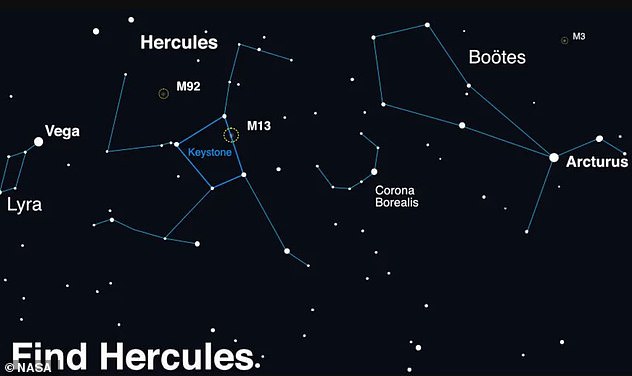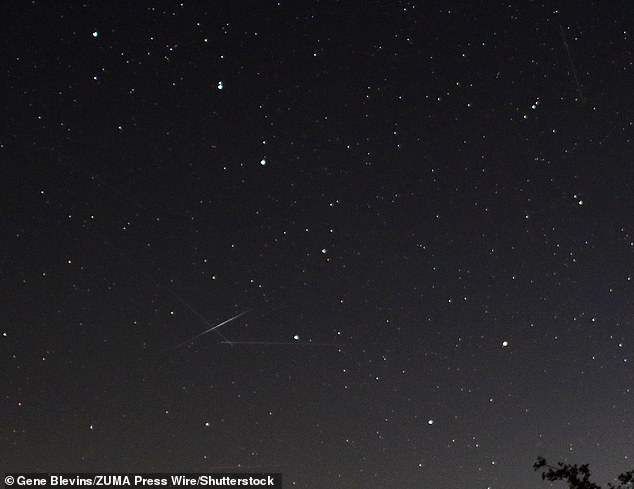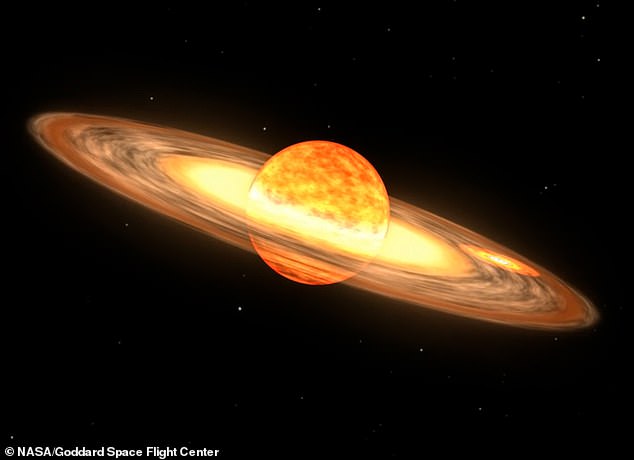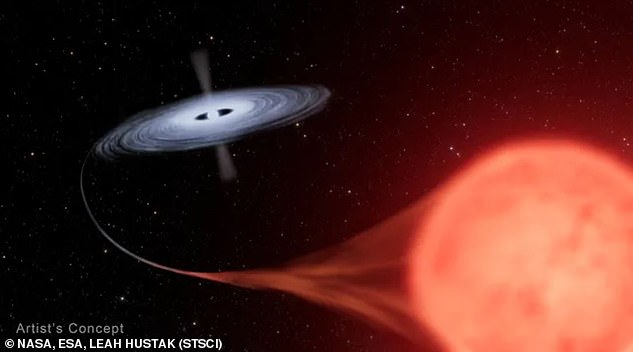See the birth of a new STAR: The new ‘Blaze Star’ will ignite in the night sky ‘any day now’ – here’s how to spot it
The night sky is so constant and unchanging that generations of sailors have determined their course based on the fixed alignment of the stars.
But soon, stargazers will have the unique opportunity to watch a new star being born in the sky.
The ‘flaming star’ T Coronae Borealis will now come to life any day, going from invisible to as bright as the North Star in a spectacular nova.
Once the nova appears, it will be visible to the naked eye for a few days before disappearing for another 80 years.
Dr. Rebekah Hounsell, a NASA expert on nova, says: ‘There are a few recurring novas with very short cycles, but typically we don’t see a repeat eruption very often in a lifetime, and rarely one so relatively close to ours. is. system.’
Dr. Hounel adds that this is a “once-in-a-lifetime event” to get front-row seats to a truly special cosmic event.
To discover this unique phenomenon, all you have to do is look to the northeast on a dark, clear night.
The blazing star will appear in a faint constellation called the Northern Crown, or Corona Borealis, between the constellations Boötes and Hercules.
But if this is difficult to spot, there is a method to narrow your search using some of the brighter stars in the sky.
First look for the Big Dipper, also called the saucepan or plough, and follow the curve of its ‘handle’ until you find a bright reddish star above the eastern horizon.
Stargazers get a unique opportunity to watch the birth of a new star as the ‘Blaze Star’ T Coronae Borealis comes to life (artist’s impression)
From that star, called Arcturus, look northeast at the same level and you should see another bright star called Vega.
Halfway between these two you can find a faint swirl of seven stars – this is the Northern Crown where the Blaze Star will appear.
Of course, it will be a lot easier to find the constellation once the flaming star has appeared, as it should be one of the brightest in the sky.
For the best viewing conditions, make sure you stay far away from light sources that could spoil your vision.
That might mean moving away from city lights whenever possible and avoiding your flashlight while your eyes adjust to the darkness.

To find the start, look for the constellation Corona Borealis, which is located between Hercules and Bootes in the northeast
The star is visible with the naked eye, but you can see more if you use binoculars or a small telescope.
There’s no way to know exactly when the star will come to life, and even scientists are eagerly awaiting signs of activity.
T Coronae Borealis is predicted to appear sometime between now and September, but that could happen any day.
Although the term ‘nova’ comes from the Latin for ‘new star’, in reality it will only appear that a new star has been created.
In reality, we will see the moment when a very faint star located 3,000 light-years from Earth suddenly brightens.
T Coronae Borealis is a binary system nestled in the Northern Crown constellation, meaning it consists of two stars orbiting each other.

To find the star, follow the handle of the Big Dipper (pictured here from the Northern Hemisphere) and look for a reddish star called Arcturus. The blazing star should appear halfway between this star and another bright star to the northeast called Vega
One of those stars is a huge but cool red giant, while the other is a white dwarf: a hot, dense remnant of a dead star, about the size of Earth but with the same mass as our Sun.
As these stars spin, the white dwarf slowly devours its neighbor, removing the hydrogen from its atmosphere.
As this hydrogen builds up around the white dwarf, it builds up enormous pressure and heat.
When enough matter falls into the star at once, it causes a huge thermonuclear explosion, so bright we can see it from Earth, blowing away the built-up material.
But unlike a supernova, which happens when a star dies, the white dwarf remains intact so the process can begin again.

T Coronae Borealis is a binary system, meaning it actually consists of two stars orbiting each other (artist’s impression)
Because this build-up takes about 80 years, T Coronae Borealis flares on a regular cycle, making it a recurring nova.
The first time the star was noticed was more than 800 years ago, in 1217, when a man named Burchard, Abbot of Ursberg, Germany, “saw a faint star shining for a time with great light.”
This is also how scientists know the star is about to burn again, as it follows the same pattern as in 1866 and 1947.
In those cases, the star first brightened before suddenly fading in anticipation of the Big Bang.
Scientists have been seeing T Coronae Borealis getting brighter again since 2015, until it suddenly turned darker in March last year.
When the wind finally blows, it can become up to 600 times brighter based on previous outbursts.

As this artist’s impression illustrates, the white dwarf is pulling matter away from its red giant neighbor. This builds up until it causes a nuclear explosion so bright we can see it from Earth
Because T Coronae Borealis is quite close to Earth and flares up regularly, it is also a great opportunity for scientists to learn more about novae.
The nova will be closely watched by scientists around the world using the James Webb Space Telescope, the Fermi Gamma-ray Space Telescope and many others.
Dr. Elizabeth Hays, head of the particle physics laboratory at NASA Goddard, says this means the help of amateur stargazers will be crucial to capture the first moments of the explosion.
‘We will observe the nova event at its peak and during its decay, as the visible energy of the eruption fades.
‘But it is just as important to obtain data during the early rise to the eruption – so the data collected by those enthusiastic citizen scientists now searching for the nova will dramatically contribute to our findings.’
